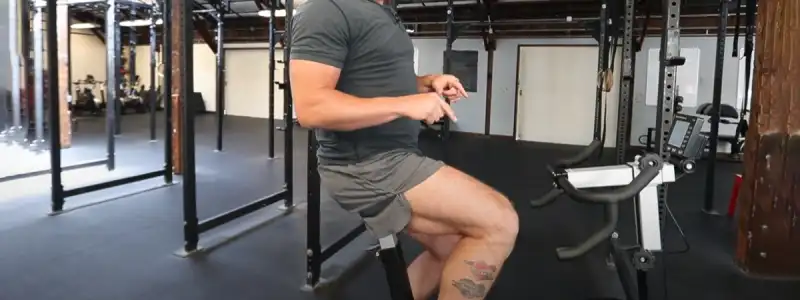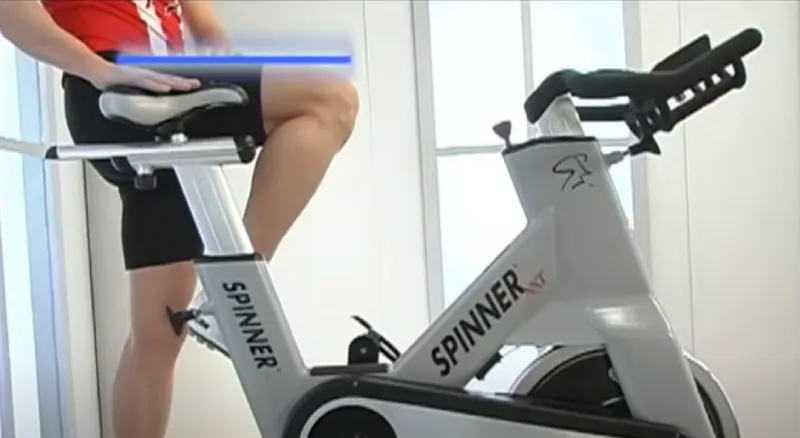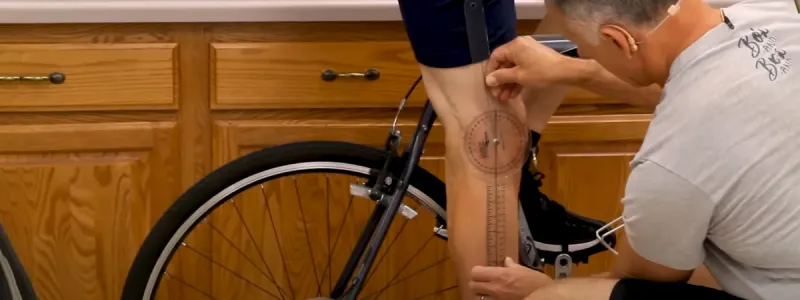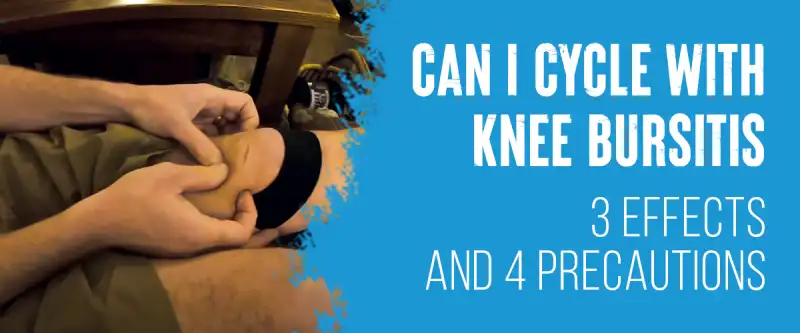Knee bursitis occurs when fluid-filled sacs (bursae) cushioning the knee joint get inflamed. This inflammation can hinder walking, work, and social activities, causing swelling, redness, stiffness, and limited mobility.
Untreated bursitis may cause chronic pain and weakened muscles around the knee, increasing the risk of future injuries.
Avoid activities that worsen your symptoms. You don’t have to stop exercising altogether. Instead, explore suitable alternatives.
Among the recommendations of the American Academy of Orthopaedic Surgeons are low-affected activities such as cycling, which have significant benefits.
In This Blog post, we will explore Can You Cycle With Knee Bursitis, its effects, precautions, advantages, and tips for a cycle with knee bursitis.
Can I Cycle With Knee Bursitis? 5 Tips & 4 Benefits

Cycling with knee bursitis may seem daunting, but taking the proper approach and precautions allows you to reap the rewards of this activity while minimizing discomfort.
Here’s an exploration of how cycling can effectively ease symptoms of knee bursitis, from mitigating inflammation to improving circulation, muscle strength, and joint flexibility.
Inflammation and Pain in Knees with Bursitis
One of the primary benefits of cycling for knee bursitis is that it can help reduce inflammation and pain. Cycling is a low-affected activity that does not strain the knee joint excessively.
As a result, you can engage in cycling without irritating your bursitis. Cycling helps increase blood flow to the affected area, which promotes healing and reduces inflammation.
Circulation and Muscle Strength
Cycling improves circulation and muscle strength, which is essential for recovering from bursitis. You get a good workout when you cycle, strengthening the muscles surrounding your knee joint.
Stronger muscles mean better support for your knee joint, which can prevent further damage and reduce inflammation. Your body’s circulation is improved by cycling, which promotes healing and reduces pain and stiffness.
Knee Joint Flexibility and Range of Motion
Your knee joint’s range of motion and flexibility can be improved by cycling. Your knee joint is lubricated when you cycle because you engage in a repetitive movement.
The result is enhanced joint flexibility and reduced pain and stiffness. The release of synovial fluid in your knee joint helps improve joint function and reduce inflammation.
Cycling with Knee Bursitis: Types
There are several types of knee bursitis, each with unique traits. Let’s explore these types to understand them better.
Infectious Bursitis Knee: The Bacterial Battle
Infectious Bursitis Knee is another form of bursitis triggered by bacteria.. Unlike septic bursitis, it doesn’t necessarily start from an open wound. Prompt medical attention can effectively control bacterial infection.
Infrapatellar Bursitis: The Lower Knee Concern
This bursitis occurs just below the kneecap and is often caused by frequent kneeling or direct impacts to the knee.
Infrapatellar Bursitis: The Lower Knee Concern
This bursitis occurs just below the kneecap and is often caused by frequent kneeling or direct impacts to the knee.
Pes Anserine Bursitis: The Hamstring Hitch
Pes Anserine Bursitis affects the area where the hamstring tendons attach to the shin bone (tibia). It can occur due to overuse or stress on the knee.
Cyclists with knee bursitis: Recognizing the Symptoms
When you’re cycling and have knee bursitis, you might notice certain symptoms that indicate the condition.
Tenderness
How It Feels: The area around your knee may feel tender to the touch. It might hurt more when you press on it or move, including during cycling.
Managing Tenderness: Gentle exercises and rest can help. Avoid putting too much pressure on the knee, especially when cycling.
Swelling
How to Spot It: Look for puffiness around the cycling knee joint. It might make your knee look more significant than usual.
Dealing with Swelling: Elevating your leg and applying ice can reduce swelling. Compression bandages may also help.
Warmth Around the Affected Area
What You Might Notice: The skin over your cycling knee might feel warmer. It is caused by increased blood flow to the area.
When to Be Concerned: If the warmth is accompanied by redness or more severe pain, it’s best to consult a healthcare professional.
Cycle with Knee Bursitis: 4 Precautions
Whether you can still cycle with knee bursitis may be on the minds of cycling enthusiasts suffering from knee bursitis. Cycling with knee bursitis may be possible most times with proper precautions and modifications. You can cycle with knee bursitis if you follow these precautions.
Proper Bike Setup
A proper bike setup reduces pressure on the affected knee. To optimize your bike fit, follow these guidelines:
- Adjust your saddle to bend your knees slightly at the bottom of your pedal stroke.
- The saddle fore/aft position should be adjusted to align the knee with the shoe ball.
- Check your handlebar position if you are reaching too far or too close.
- The right shoes, pedals, and cleats will ensure optimal power transfer and knee alignment.
Appropriate Resistance Levels
To avoid aggravating bursitis, cyclists should use resistance levels. To ensure proper resistance levels, follow these tips:
- As your knee tolerates, begin with low resistance levels and accumulate them.
- When your knee is healing, avoid standing and high-intensity cycling.
- Listen to your body and reduce resistance if you feel pain or discomfort.
Gradual Increase in Duration and Intensity
The duration and intensity of cycling should be gradually increased to avoid overexertion and further injury. To promote gradual cycling progression, follow these tips:
- Start with short, manageable sessions and focus on your body’s signals.
- Over the next few weeks, accumulate your cycling duration and intensity.
- If your knee symptoms improve, accumulate your cycling volume.
Exercise without Overexertion
Overexertion can worsen knee bursitis symptoms, so avoiding it is crucial. To prevent overexertion, follow these guidelines:
Recommended Exercises for Knee Bursitis
Exercise plays an essential role in managing knee bursitis. Strengthens the muscles around your knee, reduces inflammation, and improves flexibility. Here are some recommended exercises:
- Leg Lifts: This exercise strengthens your quadriceps without putting pressure on your knees.
- Hamstring Curls: Hamstring curls help strengthen the back of your thigh, which can support and stabilize your knee.
- Cycling: Cycling can be a fantastic, low-impact exercise for knee bursitis, particularly on a stationary bike. Just adjust the seat height correctly to avoid extra knee strain.
Exercises to Avoid for Knee Bursitis
While exercising is essential, certain activities can exacerbate your knee bursitis symptoms. Here are some exercises you should avoid:
- Running or Jogging: High-impact exercises like running can put more stress on your knees.
- Jumping Exercises: Any exercise that involves jumping can worsen your knee bursitis.
- Deep Squats or Lunges: These exercises may put too much pressure on your knees, increasing inflammation.
Stretches for Knee Bursitis
Stretching is another beneficial way to manage knee bursitis. Regular stretching can improve flexibility and reduce pain. Here are some stretches you can try:
- Quadriceps Stretch: Targets the front of your thigh, helping to relieve tension and support your knee.
- Hamstring Stretch: Hamstring stretches can alleviate tightness at the back of the thigh, affecting knee alignment and mobility.
- Calf Stretch: Tight calf muscles can put extra strain on the knee. Regular calf stretches can help alleviate this issue.
Knee Bursitis Treatment Home Remedies

You can still cycle with knee bursitis as long as you take the proper precautions and follow the right treatments. Here are some home remedies that can help manage your symptoms and keep you pedaling:
Wearing Kneepads
One of the simplest ways to protect your knees while cycling is by wearing kneepads. These provide extra cushioning and support, reducing the impact on your joints.
Rest Your Knee
One of the most effective ways to alleviate the discomfort from knee bursitis is by giving your knee enough rest.
- You should avoid excessively straining your knee.
- If you must cycle, ensure you’re not overdoing it. Listen to your body and stop when you feel pain.
Pain Management
Inflammation and pain can be reduced with over-the-counter pain relievers.
- Non-prescription drugs like ibuprofen can help.
- Always follow the manufacturer’s instructions and avoid long-term use without medical advice.
Apply Ice Packs
Cold therapy can help soothe inflamed bursae and reduce swelling.
- Use an ice pack for 15-20 minutes at a time.
- Your skin will be protected by an ice pack wrapped in a towel.
Gentle Compression
Compression can help manage swelling and provide support to the affected knee.
- Use a compression bandage or knee brace.
- Be careful not to wrap it too tight, which could interfere with blood circulation.
Elevate Your Knee
Elevation helps reduce swelling by improving blood flow.
- Try to keep your knee at or above the level of your heart whenever possible.
- Use pillows or cushions to support your leg.
Maintain a Healthy Weight
Gaining weight puts additional pressure on the knees, worsening bursitis symptoms.
- Exercise regularly and eat a balanced diet.
- A healthcare provider or nutritionist can provide you with personalized advice.
Knee Elevation
Elevating your knee can help reduce swelling and discomfort.
- Prop your knee up on pillows, especially when resting or sleeping.
- Aim to keep it elevated as much as possible.
Stationary Cycle for Knee Bursitis: 4 Advantages

Stationary cycling is a beneficial exercise for knee bursitis patients, providing low-affected movement to relieve discomfort and promote joint mobility. It is highly adjustable, adaptable to individual fitness levels, and helps build strength and endurance.
Low-affected Exercise
Knee bursitis patients can significantly benefit from stationary cycling, which is a low-affected exercise. Regarding knee bursitis, stationary cycling is safer and more comfortable than high-affected running or jumping.
Repetitive Motion to Aid Joint Mobility
Cycling can help reduce stiffness in the knee joint by promoting joint mobility. Stationary cycling allows for a smooth and consistent action to improve knee mobility and flexibility. The procedure can significantly benefit those who suffer from knee bursitis since it can reduce swelling and pain.
Adjustable to Individual Fitness Level
Stationary cycling is a highly adjustable exercise that can be easily adapted to fit each individual’s fitness level. Patients with knee bursitis can adjust the resistance on the bike to vary the intensity of the workout and the pace at which they cycle. Patients of all ages, weights, and fitness levels can benefit from stationary cycling.
Builds Strength and Endurance
Cycling, an excellent cardiovascular exercise, can improve strength and endurance. Knee bursitis patients can improve their joint stability and support by cycling regularly, which can strengthen the muscles surrounding the knee joint. Besides improving physical fitness and energy levels, cycling can also improve cardiovascular health.
How to Cycle for Knee Bursitis: 5 Tips
Cycling offers a fantastic opportunity to enhance joint health, but it’s crucial to cycle with care to prevent knee bursitis. Discover these five invaluable tips for safe cycling, minimizing the chance of knee inflammation.
Educate yourself on correct body positioning, effective pedaling techniques, and beneficial stretching exercises to maintain healthy, pain-free joints.
Proper Body Position
Maintaining the proper body position is the key to reducing knee impact while cycling. Keep these things in mind:
- Engage your core and keep your back straight.
- During pedaling, adjust your seat height so your knees are slightly bent.
- Ensure you don’t force your knees to lock out at the bottom of the pedal stroke.
Techniques for Pedaling
An essential factor in preventing knee injuries is the pedaling technique. Knee stress can be reduced by pedaling smoothly and circularly. Here are some tips:
- Maintain a smooth pedal stroke by using a lower gear.
- Ensure that your feet are always level and parallel to the ground.
- Use your heel to push down on the downstroke; on the upstroke, use your toes to pull up.
- Don’t push too hard on the pedals, as this can cause excessive knee stress.
The Stretching Motion
Warming up your muscles and preventing knee injuries can be achieved by stretching before cycling. Try these stretches:
- Quad Stretch: Lie on your left side, bend your left knee, and hold your left foot behind you with your left hand. Switch sides after 15-30 seconds.
- Hamstring Stretch: Lie on the ground with your legs extended in front of you, reach to your toes, and hold for 15-30 seconds.
- Hip Flexor Stretch: Stretch your hip flexors by putting your left foot on the ground and kneeling on your right knee. Hold for 15-30 seconds, then switch sides.
Proper Foot and Knee Alignment

- Ensure your foot and knee are correctly aligned when pedaling to prevent unnecessary knee stress.
- Adjust your foot position with cleat wedges or pedal washers if necessary.
- The fore-aft position and saddle height should be checked to ensure your knees are correct over the pedals.
- Get your bike fit professionally to ensure it is set up correctly.
Use of Cushioned Cycling Shorts
- Invest in padded cycling shorts to avoid chafing and reduce pressure on your seat.
- Comfortable shorts should have multi-density foam, breathable mesh, and stitched seams.
- For further friction and irritation reduction, consider using chamois cream.
Conclusion
The benefits of cycling for people suffering from knee bursitis include maintaining fitness in a low-affected manner. It reduces inflammation, promotes circulation, and increases flexibility and range of motion in the knee joint.
If you take the required precautions, avoid overexertion, and ensure proper alignment and support, cycling with knee bursitis can be safe and effective. There’s no need to stop exercising if you have knee bursitis. Enjoy the benefits of a healthy routine by cycling.
FAQs
Is Cycling Likely To Worsen Knee Bursitis Symptoms?
This depends on the severity of inflammation and how much pressure the individual tolerates on the knee joint. A cyclist’s symptoms may be aggravated, more painful, and swollen when disturbed by cycling.
Does Knee Bursitis Last for A Long Time?
Knee bursitis typically improves with rest and home treatment within a few weeks. If symptoms persist after 2 to 3 weeks, consult your healthcare provider for further evaluation. Medical treatment may be necessary for prolonged cases of knee bursitis.
How Do You Diagnose Knee Bursitis?
You will be asked about your symptoms and medical history. You will then be examined for pain and tenderness, and the range of motion of your affected knee will be assessed using X-rays, Ultrasound, and MRI scans. Imaging tests can help confirm a prepatellar bursitis diagnosis or rule out other possible conditions.You will be asked about your symptoms and medical history. You will then be examined for pain and tenderness, and the range of motion of your affected knee will be assessed using X-rays, Ultrasound, and MRI scans. Imaging tests can help confirm a prepatellar bursitis diagnosis or rule out other possible conditions.
Is Knee Bursitis Surgery Necessary?
The treatment of knee bursitis may require surgery if antibiotics and other treatments are not effective. The infected bursa may need to be surgically removed if conservative measures do not relieve the symptoms. Your healthcare provider can determine the most appropriate course of action for your knee bursitis.


